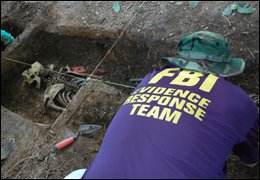|
The Body Farm Tennessee: FBI Recovery of Human Remains Course
The FBI Recovery of Human Remains course is an annual week-long field study for 40 special agents and professionals who are Evidence Response Team members in field offices around the country. The popular course, held each May at the “Body Farm” at the University of Tennessee in Knoxville, pairs teams of agents with leading forensic anthropologists to learn how to best identify and excavate human remains to preserve the many clues and pieces of evidence that decaying bodies may leave behind. Day One is classroom instruction and lectures from experts in the field, including Dr. William M. Bass, who in 1981 created the Anthropological Research Facility, or Body Farm, on a wooded hillside behind the University of Tennessee Medical Center. There, some 70 bodies that were left to science are laid out in various states of repose—buried, exposed, entombed. Bass began the venture as a novel way to study human decomposition and insect activity, but it has evolved into an important teaching environment. “The initial use of the facility as a training classroom began with the Bureau,” said Dr. Murray K. Marks, a forensic anthropologist and protégé of Dr. Bass who helps run the FBI course. In fact, it was in 1999 that the FBI, after participating in several large-scale body recovery operations overseas, linked up with the Body Farm to get expert instruction on human remains recovery. Agents learn the technical aspects of what is essentially an archeological dig—probing for loose soil, measuring datum points, and the painstaking work of removing soil by hand. On the morning of Day Three, the agents don protective Tyvek suits, rubber gloves, and boots and divide into teams. Their task over the next two days: find a buried body, excavate it, and see what clues emerge. “We don’t go in with mechanical equipment or even shovels,” said Special Agent Gary Reinecke of the Evidence Response Team Unit at the FBI Laboratory in Quantico, Virginia. Reinecke’s experience digging up evidence of war crimes in Kosovo led, in part, to the human remains course. The work is slow and methodical to preserve potential evidence. “They’ll be on their hands and knees with hand trowels and other small tools, brushes, and eventually they’ll find the remains.” One agent offers a preview: “I definitely don’t think anyone could just walk in here and deal with the smell and also the sight of a human being decomposing,” said Medora Arnaud, a field photographer in our Houston field office. “But you know you have a job to do. And I’m sure a lot of times that’s what gets a lot of people through it.” (Information courtesy of the Department of Justice) Looking For Something In Particular? Try Google Search Go Back To The Forensic Anthropology Page Go From The Body Farm Back To The Home Page |





